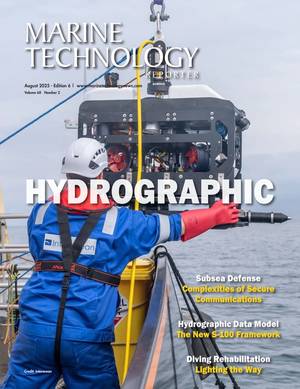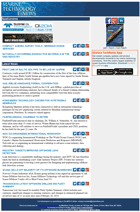
Kraken Robotics Appoints BlueZone Group as Sales Representative for Australia, New Zealand
Kraken Robotics Inc. announced the appointment of BlueZone Group as an authorized reseller of Kraken Synthetic Aperture Sonar (SAS) and the KATFISH towed SAS platform in Australia and New Zealand.This year, Kraken partnered with BlueZone Group to service the Royal Australian Navy’s (RAN’s) KATFISH and ISO20 LARS aboard HMAS Leeuwin. The system is now operational under the management of RAN’s Hydrographic Service. Together, Kraken and BlueZone delivered the first Depot-Level Maintenance service on the KATFISH towed SAS system in under one month, demonstrating the value of in-country

Ghost Shark Factory Opens in Sydney
Seven weeks after the Royal Australian Navy awarded a A$1.7 billion Program of Record, Anduril has officially opened its new Ghost Shark manufacturing facility in Sydney.The opening coincides with the first Ghost Shark extra large autonomous underwater vehicle (XL-AUV) being completed ahead of schedule and ready for sea acceptance testing ahead of planned delivery to the Royal Australian Navy in January 2026.The platform is designed to conduct intelligence, surveillance, reconnaissance and strike operations, stealthily and at long range.The new 7,400m² facility is purpose-built to produce Ghost

Down Under
scientific research purposes, we can expect AI-powered AUVs to play a vital role.”Hydrus AUVs. Credit: Advanced NavigationQ-CTRLAustralian quantum software company Q-CTRL has demonstrated its software-ruggedized quantum sensing for navigation technology in a major field trial onboard the Royal Australian Navy’s multi-role aviation training vessel, MV Sycamore. Quantum navigation promises a robust and reliable GPS backup that cannot be jammed or spoofed.Quantum sensing leverages the physics of light and matter on the smallest scales to enable the detection of tiny signals. Because these devices

Australia Advances Ghost Shark AUV Investment
The Australian Government is investing A$1.7 billion ($1.1 billion) to acquire a new fleet of Australian‑designed and built extra-large autonomous undersea vehicles – known as the Ghost Shark – for the Royal Australian Navy. The Department of Defence has signed a contract with Anduril Australia for the delivery, maintenance and continued development of the Ghost Shark over the next five years.The platform is designed to conduct intelligence, surveillance, reconnaissance and strike operations, stealthily and at long

Greenroom Robotics Granted AUKUS Exemption for Autonomous Vessel Software
significant barriers on defence trade in August through an exemption to the U.S. International Trafficking in Arms Regulations, designed to speed up construction of nuclear-powered submarines under the Australia-UK-US (AUKUS) pact.The co-founder of the Greenroom Robotics startup, former Royal Australian Navy engineer Harry Hubbert, told Reuters the licence exemption will also speed up the company's collaboration on autonomous vessel trials with defence companies in Britain and the United States.Greenroom's software acts like "the brain of a vessel", he said, emulating what a helmsman

Cellula Robotics Unveils Vigilus Underwater Surveillance Solution
for timely data-driven decisions, Cellula Robotics said. Furthermore, Vigilus offers an additional layer of strategic advantage, as each node can emit acoustic pings to serve as a deterrent while deployed.The genesis of Vigilus can be traced back to a successful prototype developed for the Royal Australian Navy (RAN), the manufacturer noted.Innovation, Science, and Economic Development Canada has awarded a contract to Cellula Robotics Ltd. for its Vigilus array following a successful call for proposals under the Innovative Solutions Canada Testing Stream. Transport Canada is acting as the technical

Kraken Robotics Supplies High-Resolution Seabed Mapping Sonar Solution to Australian Navy
Canadian marine robotics company Kraken Robotics said Monday it had supplied high-resolution seabed mapping sonar equipment to the Royal Australian Navy. Kraken delivered its KATFISH high-speed high-definition seabed awareness solution in Q2, and recently completed system integration and sea trials in Cairns, Australia. Kraken expects to provide additional in-service support including training, spares and operational support. "Continuing to build off successful KATFISH deliveries with various NATO navies, this represented Kraken’s first KATFISH system sale in the Asia-Pacific

In the Navy:The Role of Advanced Sea Mines in Future Conflicts
, viable sea denial capability in the face of growing threats from Russia and China. Italian company RMV Italia, for example, a division of German auto and arms manufacturer Rheinmetall, markets the Murena and Asteria bottom mines, and is rumored to be a possible future supplier to the Royal Australian Navy as Canberra seeks to deter Chinese maritime aggression. Finnish company DA-Group produces an advanced bottom mine, the Turso MM20, which can be fitted with a range of sensors, and operates at depths of 10 to 200 meters. DA-Group also markets a modular minelaying system called Sumico, which

Australia Outlines $245 Billion Nuclear Submarine Plan
program would start with a A$6 billion ($4 billion) investment over the next four years to expand a major submarine base and the country's submarine shipyards, as well as train skilled workers."This will be an Australian sovereign capability - built by Australians, commanded by the Royal Australian Navy and sustained by Australian workers in Australian shipyards," Albanese said in San Diego, California."The scale, complexity and economic significance of the investment is akin to the creation of the Australian automotive industry in the post-war period," Albanese added.Australia

 August 2025
August 2025




